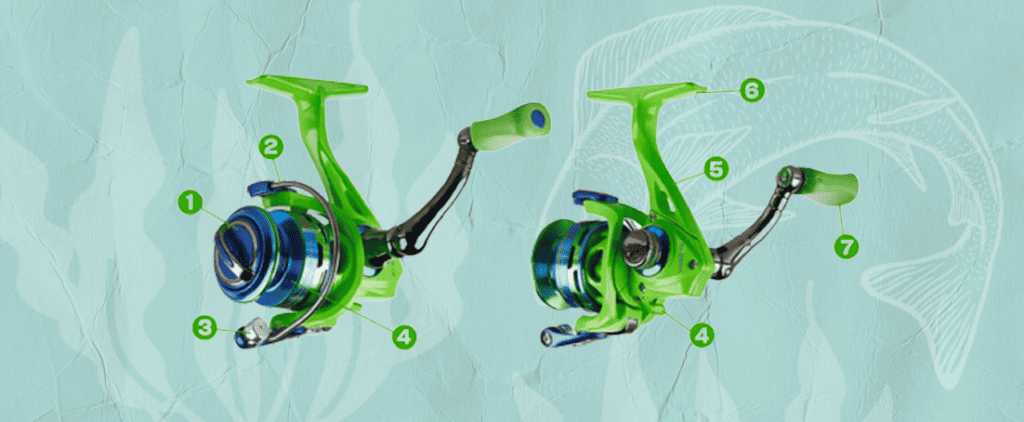
Getting the best out of your spinning reel is easier when you understand the important fishing reel parts and what they do. Mastering the parts of a fishing reel creates a stronger, self-sufficient angler. You are learning what to fix or modify, when, and why, eventually leading to more fish.
Setting up and changing your fishing reel to fit goals and circumstances makes you more efficient. You can perfect your gear or set it up informally simpler if you know its parts and their functions. It also helps you purchase the right spinning reels for the intended application.
In this article, we’ll go over the essential spinning reel components. By the conclusion of this article, you’ll be significantly more capable of making the most of your new bait caster. Our focus is on What are the Parts of a Spinning Reel?”

Daddy by day, fisherman at night.
Table of Contents
Each Spinning Reel Part Explained
Foot
The reel foot is the rectangular upper part of the reel that sits on the reel seat of a spinning rod. It usually an extension of the reel body, made from the same material, such as graphite or aluminum.
It has to be strong enough to withstand all the pressure and vibrations during various fishing techniques and sit on a reel firmly. Remember that not every rod and reel are compatible, hence read the manufacturer’s instructions about fitting it.
Body
The reel body or housing is the first thing you will notice on your fishing reel. Its primary purpose is to hold all of the parts of a fishing reel together. Reel bodies are the main component of the reel. Your reel body should be solid with smooth operation and no loose parts.
The reel body can be made from graphite, aluminum, or a combination of those or other materials. When compared to graphite, aluminum is strong and more resilient. A lighter reel is more comfortable to hold for long periods. Avoid reels made of plastic components.
Saltwater spinning reels have corrosion-resistant reel bodies; the better the material, the higher the price.
Handle
The handle is a part you hold when using a fishing reel. Since it is rotated by the hand, the reel handle should be smooth and comfortable. Most spinning reels have left – and right-hand options so anyone can use them.
If you look at a spinning reel parts diagram, you will notice that some handles have a rubber grip. This prevents your wet hands from slipping.
Most reels have handles made from the same materials as the body. So you can find fishing reels with graphite or aluminum. These materials can withstand the pressure of turning.
Spool
The line spool is part of a spinning reel that holds the fishing line. Also, spool line capacity determines the fishing line you can use. A good spinning reel spool holds less line capacity to avoid too much friction during line retrieval.
Unlike baitcasting reels, the spool does not rotate; it oscillates. The oscillation ensures the fishing line is evenly distributed on the spool. Spools on spinning reels are usually made from graphite or aluminum, like the reel handles and bodies. Graphite is lighter, but an aluminium spool is more powerful.
Another thing to keep in mind is if the spool is braid-ready. Using a spinning reel with a braided line is easier than if it is purchased separately.
Drag adjustment
The drag adjustment knob is part of the spinning reel, which an angler turns to increase or decrease drag on the fishing line. Drag adjustment is crucial when battling a fish that drags the string under the water as it tries to escape. The drag knob resides near the handle, to allow for quick modifications when throwing and retrieving.
Good drag systems are simple to modify, and the line spool moves evenly and smoothly without snapping at any level. The optimal setting of the knob also depends on the snapping power of the string.
Bail arm
The bail sits next to the spool. It is a wire-like semicircular part unique to spinning reels and enables even line lay. It facilitates even unwinding and reeling of the line spool. It makes casting with spinning reels simpler hence making them ideal for beginners.
An advanced bail arm comprises thin metal parts attached to the reel body. Bail arms on top-notch fishing reels should be simple to release, retract strings, and have little friction. Avoid which weak bail arms as they won’t endure repeated usage.
Anti-reverse switch
Anti-reverse the spinning reel part responsible for stopping the handle from rotating backward when fighting fish. It is important in spinning reels for bass fishing. It prevents the spool from turning backwards, causing unruly tangles, breaks, and snags when fighting fish. Which is why trout spinning reels are similar to bass ones.
Most spinning reels have a switch that lets the angler set it on or off. Anti-reverse switch on spinning reel also prevent the drag from moving backward. When the line is off, anti-reverse allows the line to reel in reverse rather than relying on the drag system to maintain line tension. It can work effectively for light fish, but most anglers use a drag system.
An anti-reverse system is found on the latest spinning reels. It is an important feature for achieving longer casting distance and line management.
Line roller
A line roller is a small, round part on the bail end. It holds the line in place as the reel moves up and down during rotation. It adds to the overall feel of a spinning reel by being the contact point of the line as it is reeled in from a cast.
Anglers want to eliminate the friction caused by ragged edges or surfaces. A roller helps to avoid the line being weakened or broken off. Look for a line roller with nowhere for the line to catch. A roller with a bearing is best, but they’re usually found on more expensive reels.
Internal parts of a spinning reel
Drag system
Internal drag system fishing reel parts are discs or washers attached to the spool. They cause friction among one another, which slows the spool. This friction creates a lot of heat. The materials on a good fishing reel should divert the heat from the spool and not heat too much.
Many reels have composite or carbon fiber drag systems Carbon fiber discs are always a better option.
Gearbox
Gears are essential parts of a spinning reel that guarantee the smooth operation of a reel’s action and avoid nasty line breaks. Gears are circular metallic parts that are found in the reel’s body. The gearbox is crafted out of zinc, brass, stainless or aluminum.
Gears also play a fundamental role in determining the key characteristic of gear ratio. Gear ratio denotes the number of spool rotations produced by spinning the reel handle once
The gear ratio for reels that spin tends to vary from 4:1 to 7:1. The number of rotations per turn is indicated by the first number in the specification of the handle.
Ball bearings
These are ball-shaped bearings for reducing friction and ensuring smooth reel operation. They are located between a fixed axle within the center and a moving wheel on the outside.
What is important about ball bearings is their quality. The reel could have as many ball bearings but if they are not of the same caliber they will be useless. Most reputable companies will have at least four ball bearings.
Frequently Asked Questions
The lever is called an anti-reverse switch. When the anti-reverse function is activated when the switch is in the on position. At this time, your spool will not turn so that it releases the line. It is crucial for ensuring the line does not get tangled.
The anti-reverse mechanism in a spinning reel enables you to back-reel instead of employing a drag technique. It activates the drag and stops the reel from going backward.
Back reeling is more effective over the reel drag system while fighting smaller fish. However, you should switch it off when targeting big fish.
Cotton swabs and isopropyl rubbing alcohol are used to clean the exterior of the reel. Clean excess grease, oil, salt deposits, or dirt. Cleaning reels helps to avoid costly inspections and clean line roller assembly.
